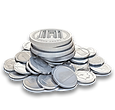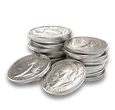🪙 When Is the Right Time to Sell Gold or Silver? [The Complete 2025 Guide]
- GoldsilverJapan
- Sep 6
- 6 min read
One of the most frequently asked questions in the world of precious metals is this:
“When should I sell my gold or silver?”
It seems simple at first—but if you dig deeper, you’ll realize this is not just a timing question. It’s a value question. It’s a personal question. And in many ways, it’s a question about your endgame.
This article is designed to answer key search queries like:
“Is now a good time to sell gold?”
“When should I sell my silver?”
“What to do when gold hits all-time highs?”
“Should I wait or sell my gold now?”
“How to know gold’s real value?”
We’ll also break down several core concepts:
Price vs Value
Precious Metals vs Other Assets
Understanding the Endgame
Mistakes to Avoid When Selling
Personal Strategy for Different Scenarios
Let’s get into it.
💰 1. Price vs. Value – Why It Matters More Than You Think
One of the biggest traps in precious metal investing is focusing solely on price, especially the nominal price in fiat currency (like USD, JPY, or EUR). You see gold reach an all-time high of $3,500 (hypothetical) or silver hit $50, and you think:
“That’s it! Time to cash in.”
But wait.
Before you sell, ask this critical question:
🧠 Is the value of gold increasing… or is the currency collapsing?
If the dollar, yen, or euro is losing purchasing power due to inflation, then everything will go up in price — food, fuel, real estate, and yes, gold and silver too. In such a scenario, selling just because the price is higher could be a mistake.
It’s important to look at:
Gold-to-real-estate ratio
Gold-to-stock market ratio
Gold-to-wages ratio
Silver-to-oil ratio
These ratios help reveal gold’s true value relative to real-world goods—not just inflated paper numbers.
🏦 2. Gold or Silver’s Price vs Other Assets
Let’s go deeper.
When people ask, “Should I sell now?” they often forget to ask, “What will I do with the money?”
That’s the bigger question.
If you sell gold or silver at a perceived top, but move the cash into:
A declining stock market,
Overpriced real estate,
Or fiat cash that’s being inflated away...
Then what have you really gained?
Instead, look at the value spread between gold/silver and other assets.
Examples:
If 100 oz of silver buys a used car today, but in 5 years it buys a new car → that’s real value increase.
If 50 oz of gold buys a small apartment now, but in 3 years it buys a house → that’s strategic timing.
So, sometimes the right time to sell is not when metals are “high,” but when other assets are cheap.
🔁 3. What’s Your Endgame? Define It Before You Sell
This is the question most people skip.
They stack metals for years, and then one day sell out... without a plan.
So, before selling gold or silver, ask:
“What’s my endgame?”
Endgame Scenarios:
Buying land or a home
Retiring early
Funding a child’s education
Moving into a different currency or asset class
Starting a business
Escaping systemic risk
If your answer is “just holding cash in the bank,” then be careful.
In a world of currency devaluation, holding too much fiat money can be riskier than holding metals.
A better strategy might be:
Sell in portions
Swap for undervalued hard assets
Avoid fiat unless necessary
Having clarity on your purpose makes selling much easier—and more profitable in the long run.
⏰ 4. Timing the Market vs Reading the Signals
While “buy low, sell high” is a good principle, the reality is: timing the exact top is nearly impossible.
Even seasoned investors rarely sell at the peak. So instead of trying to be perfect, look for macro signals:
📉 Signals That May Suggest Selling Gold/Silver:
Gold-to-Dow ratio approaches 1:1
Silver-to-gold ratio compresses to under 30:1
Real estate prices crash while metals soar
Political calm returns after economic panic
Interest rates normalize and inflation drops sharply
These signals suggest metals are expensive relative to everything else, and rotating into other assets might make sense.
⚠️ 5. Top Mistakes People Make When Selling Precious Metals
❌ 1. Selling Just Because Prices Go Up
As we said earlier: price isn’t everything. Value and timing matter more.
❌ 2. Going All-In or All-Out
Selling 100% of your stack at once exposes you to timing risk. Instead, consider selling in tiers based on personal goals.
Example:
Sell 10% when silver hits $50
Another 20% when it hits $60
Hold core position for emergencies
❌ 3. Ignoring Taxes
In many countries, capital gains tax applies when selling gold or silver. Be prepared, and document your original purchase price.
Consult a tax advisor.
❌ 4. Not Planning Re-entry
If you sell and metals fall again—what’s your plan to re-enter? Stay ready with liquidity or assets that can be exchanged back into metals.
📊 6. Sell Based on Ratios, Not Emotion
Gold and silver don’t move in isolation. Watch these ratios to inform your decisions:
Ratio | What It Means | Sell Signal |
Gold/Dow | How gold compares to stock market | Near 1:1 is a classic top |
Gold/Real Estate | Gold vs housing | If 1 oz = 1 month of rent → metals overvalued |
Silver/Oil | Silver vs energy cost | Silver expensive relative to oil may suggest selling |
Gold/Silver | Indicates which is more undervalued | If < 30:1, silver may be “overheated” |
Using ratios helps remove emotion and base your exit plan on logic.
🌍 7. Global Context: What World Events Signal Selling?
Sometimes geopolitical and economic events make gold rise rapidly. But what happens next matters.
Be cautious of:
War-driven spikes: Prices may drop sharply when peace resumes.
Crisis hype: Media fear can inflate demand temporarily.
Sudden interest rate cuts: Can cause a melt-up followed by a crash.
When selling, check if global sentiment is peaking. Are people panic buying? Are Google searches for “how to buy gold” at an all-time high?
If yes—it might be time to consider selling part of your holdings.
🔁 8. Rebalancing: One of the Smartest Strategies
Rebalancing means adjusting your portfolio by selling winners and adding to undervalued assets.
Example strategy:
Your portfolio was 20% gold, 30% stocks, 30% real estate, 20% cash.
Gold doubled. Now it’s 40% of your portfolio.
Rebalance by selling 10% of your gold and buying low-priced assets.
This keeps your risk balanced and profit locked in—without going all in or all out.
📦 9. Where & How to Sell Safely
If you do decide to sell, here’s how to do it right:
🔐 Trusted Selling Channels:
Reputable bullion dealers
Local coin shops (with good reviews)
Online platforms like APMEX, Kitco, GoldSilver.com
Peer-to-peer sales with verified collectors (use escrow)
✅ Tips for Safe Selling:
Always get multiple quotes.
Sell during market hours for accurate pricing.
If mailing, use insured & trackable shipping.
Consider graded or certified coins for higher resale.
🧠 My View: A Strategic Perspective
Here’s a practical view based on long-term patterns and real-world scenarios:
Don’t sell just because metals are up. Sell when other assets are more attractive relative to metals.
Selling gold to buy overvalued stocks or fiat cash is risky.
Keep a core holding of physical metal no matter what. Emergencies don’t announce themselves.
Rebalance gradually. Selling 10-20% at each high allows flexibility and minimizes regret.
Always sell with a purpose. If you’re not sure what to do with the money, you’re not ready to sell.
Remember: gold and silver are not just investments. They’re monetary insurance.
You wouldn’t cancel your fire insurance just because house prices went up.
🤔 FAQ: When Should I Sell Gold or Silver?
Q: Is it better to sell gold at an all-time high?A: Not necessarily. You must consider the value vs other assets and what you plan to do with the proceeds.
Q: Will silver go to $100 or gold to $5,000?A: No one knows. Instead of waiting for a magic number, use value ratios and personal goals to guide your decisions.
Q: What if the currency crashes after I sell?A: That’s why it’s important not to sell 100%. Keep a reserve.
Q: Is it bad to sell gold and stay in cash?A: For short periods, it’s okay. But long-term exposure to fiat currency carries inflation risk. Plan your next move.
🔚 Final Thoughts: It’s Not “When”—It’s “Why”
The best time to sell gold or silver isn’t just about price. It’s about purpose, value, and timing in relation to your goals.
Know what you’re selling for
Compare metals to other assets, not just fiat prices
Use ratios and signals, not emotion
Plan your exit and your re-entry
Stay flexible. The world changes fast.
Gold and silver are long-term tools of wealth preservation. Use them wisely—not just for profit, but for protection and positioning.







